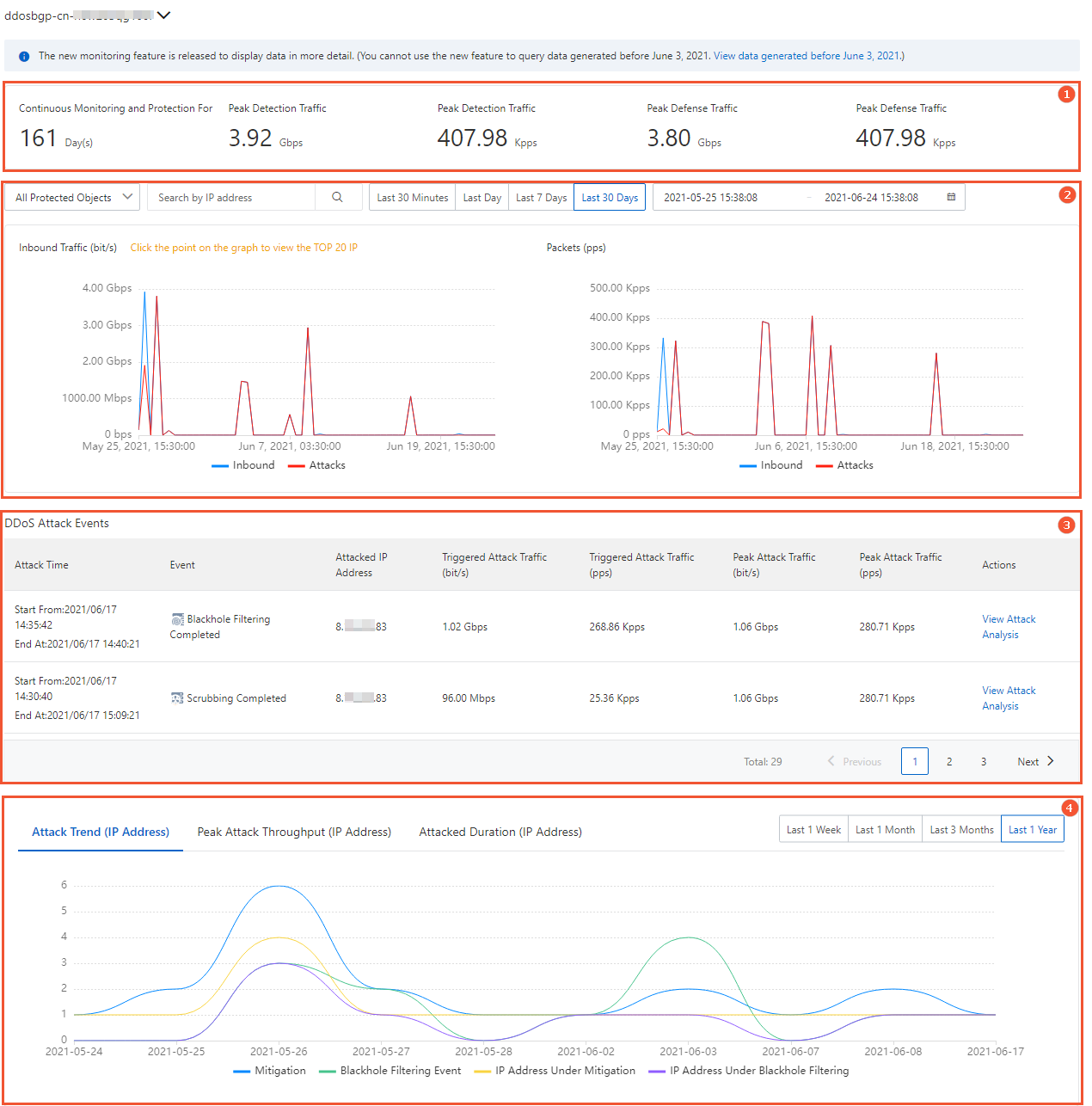The Service Monitoring page shows the protection data of the Anti-DDoS Origin instance to help you understand the security posture of your service. The protection data includes the traffic trends of protected assets and the DDoS attack events. This topic describes the monitoring data and how to query service monitoring data.
Prerequisites
For more information, see Purchase an Anti-DDoS Origin Enterprise instance and Add an object for protection.
Background information
On the Service Monitoring page, you can query data generated on and after June 3, 2021. If you want to query data that is generated before June 3, 2021, perform operations described in Manage instances.
Query service monitoring data
Description of service statistics
- Continuous Monitoring and Protection For: indicates the number of days that the Anti-DDoS Origin instance protects your assets.
- Peak Detection Traffic: indicates the peak traffic of your service that is detected by the Anti-DDoS Origin instance. The peak traffic is measured by both bandwidth in bit/s and packet forwarding rate in pps.
- Peak Defense Traffic: indicates the peak traffic of attacks that are detected by the Anti-DDoS Origin instance. The peak traffic is measured by both bandwidth in bit/s and packet forwarding rate in pps.
Description of traffic trend charts
- Inbound Traffic (bit/s): shows the trends of inbound traffic for protected IP addresses. Unit: bit/s. This chart shows the total traffic and attack traffic.
- Packets (pps): shows the trends of packet forwarding rate in the inbound direction for protected IP addresses. Unit: pps. This chart shows the forwarding rates of all packets and attack packets.
- Protected object: You can select All Protected Objects from the drop-down list or enter an IP address that is protected in the search box
to query related data.
If you select All Protected Objects, you can click a point on a trend chart to query the top 20 IP addresses that are protected in descending order by traffic volume at that point in time.
- Time range: You can select Last 30 Minutes, Last Day, Last 7 Days, or Last 30 Days. You can also customize a time range to query related data.
A custom time range must be within the last 30 days.
Description of DDoS attack events
List of attack events: shows all the attack events that are detected by the Anti-DDoS Origin instance. Each attack event record contains the following information: Attack Time, Event, Attacked IP Address, Triggered Attack Traffic (bit/s), Peak Attack Traffic (bit/s), and Peak Attack Traffic (pps).
- Cancel Scrubbing: You can perform this operation only on in-progress traffic scrubbing events. If you confirm that a traffic surge is not caused by attacks, you can manually cancel traffic scrubbing. For example, a traffic surge may be caused by promotional events.
- Download: You can perform this operation to download the packet capture files for the attack event. You can use the downloaded files as evidence to report to network supervisors.
- View Attack Analysis: You can perform this operation to view analysis details about the attack event. For more information, see View information on the Attack Analysis page.
You can specify a protected object and a time range in the traffic trend charts section to filter attack events.
Description of attack trend charts
- Attack Trend (IP Address): displays the trends of the number of attacks detected by the Anti-DDoS Origin instance. You can view the following information: Mitigation, Blackhole Filtering Event, IP Address Under Mitigation, and IP Address Under Blackhole Filtering.
- Peak Attack Throughput (IP Address): displays the trends of peak traffic of attacks detected by the Anti-DDoS Origin instance.
- Attacked Duration (IP): displays the trends of attacks by duration. The durations include Less Than 10 Minutes, 10-30 Minutes, 30-120 Minutes, 2-10 Hours, and More Than 10 Hours.
In the upper-right corner above a chart, you can specify a time range to query related data. You can select Last 1 Week, Last 1 Month, Last 3 Months, or Last 1 Year to query related data.
